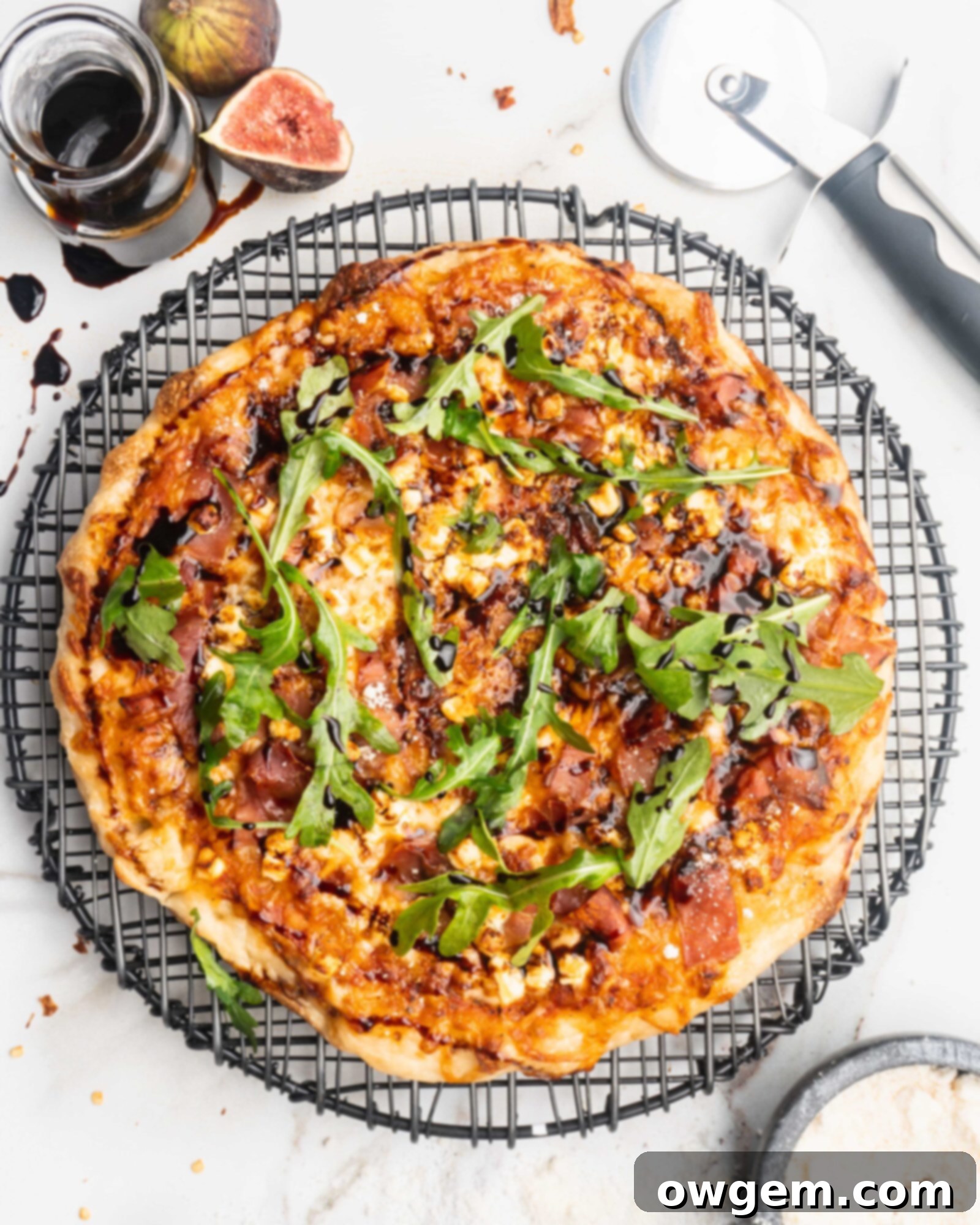Gourmet Prosciutto and Goat Cheese Cast Iron Pan Pizza: Elevate Your Homemade Pizza Experience
Dreaming of pizzeria-quality pizza without needing a professional oven? Your cast iron skillet and a standard home oven are all you need to create this extraordinary Prosciutto and Goat Cheese Pan Pizza. This recipe isn’t just easy; it’s a game-changer for homemade pizza, utilizing convenient store-bought dough and marinara to simplify the process. What truly sets this pizza apart are the sophisticated additions: savory prosciutto, tangy goat cheese, and a luscious balsamic reduction. This triumvirate of flavors creates a harmony that is nothing short of life-changing, delivering a gourmet experience right in your kitchen. Finishing with a generous handful of fresh arugula adds a vibrant, peppery bite that perfectly complements the rich and complex flavors. Prepare for an out-of-this-world culinary delight that rivals your favorite restaurant pizza!
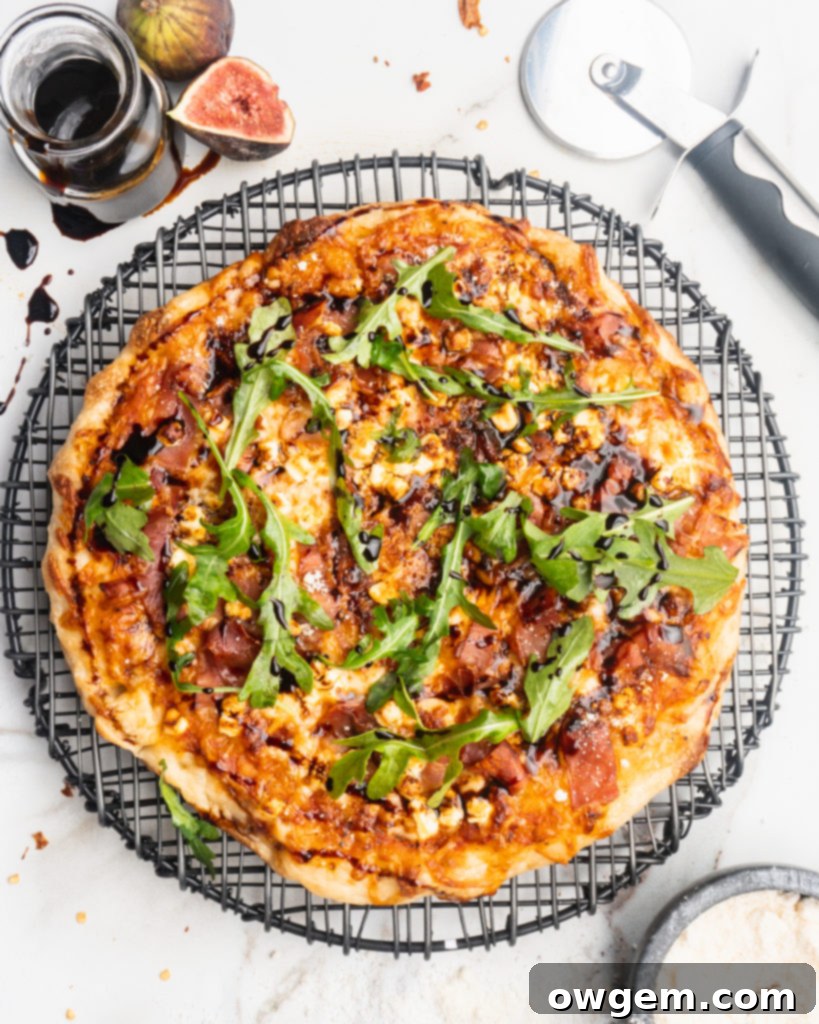
Making delicious pizza at home often feels intimidating, but with the right techniques and a few key ingredients, you can achieve remarkable results. This recipe focuses on creating a high-quality pan pizza that boasts a wonderfully crispy crust and an incredible depth of flavor, all thanks to the magic of cast iron and a carefully chosen topping combination. We’ll walk through each step, from preparing the dough to achieving that perfect golden crust, ensuring your homemade pizza is both impressive and effortless.
The Secret to a Perfect Crust: Mastering Pizza Dough Shaping
When it comes to shaping pizza dough, many home cooks instinctively reach for flour to prevent sticking. However, for this cast iron pan pizza, we’re going to break tradition and use extra virgin olive oil instead. This simple switch makes a profound difference in the final product. Flour, while effective for non-sticking, can sometimes dry out the dough or create a barrier that prevents a truly cohesive crust. Olive oil, on the other hand, acts as a superb lubricant, allowing the dough to stretch easily without tearing or sticking to your hands, the rolling pin, or your work surface. Furthermore, it imparts a beautiful richness to the dough, enhancing the overall flavor profile and contributing to a golden, crispy bottom crust that’s truly exceptional.
To begin shaping your dough, pour about a tablespoon of good quality extra virgin olive oil onto your clean work surface and spread it evenly. Place your 12 oz pizza dough (whether store-bought or homemade) on top of the oiled surface. You can use your hands, gently pressing and stretching from the center outwards, or a rolling pin. The goal is to achieve a round circle approximately 12 inches in diameter, which will perfectly fit a standard 12-inch cast iron skillet. As you work, you might notice the dough resisting and springing back into its original shape. This is a common occurrence, indicating that the gluten in the dough is a bit tight and needs to relax. Don’t force it. Simply cover the dough with a clean kitchen towel and let it rest for 15-20 minutes. This short rest period allows the gluten strands to relax, making the dough much more pliable and easier to stretch without tearing. Once rested, you’ll find it much more cooperative, allowing you to achieve the desired shape with minimal effort. The slight aroma of olive oil infused into the dough during this process also adds another layer of deliciousness to your pizza base.
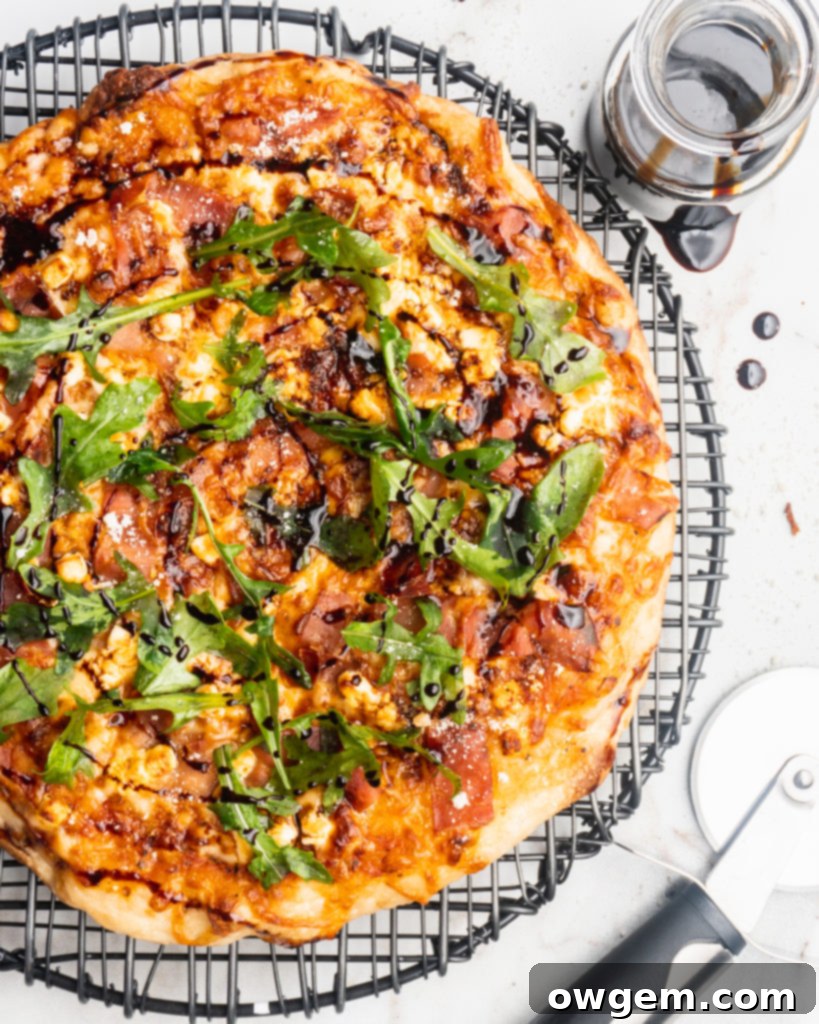
Unleashing the Power of Cast Iron: Your At-Home Pizza Oven Solution
For many pizza enthusiasts, achieving that coveted crispy, chewy crust with delightful air pockets seems like an exclusive domain of high-temperature pizza ovens or specialized pizza stones. These professional tools work by delivering an intense burst of heat directly to the dough, causing the yeast to activate rapidly and create that signature texture. The good news is, you don’t need to invest in expensive equipment to replicate this effect at home! Your trusty cast iron skillet, with its exceptional heat retention properties, can perform the same magic. This makes cast iron pans incredibly versatile kitchen tools, allowing you to fry, sear, bake, and now, make gourmet pizza!
The secret lies in cast iron’s ability to absorb and hold heat incredibly well. When preheated on the stovetop and then transferred to a hot oven, the cast iron pan acts like a mini pizza stone, providing an even, intense heat source from below. This high heat contact with the dough’s base instantly sears the crust, preventing sogginess and promoting rapid expansion of air bubbles within the dough. The result is a bottom crust that is beautifully golden and crisp, while the edges become delightfully chewy and airy. This dual-cooking method – stovetop browning followed by oven baking – is key to achieving a truly pizzeria-style crust without specialized equipment. Before you even think about buying a dedicated pizza stone, give your cast iron skillet a chance. You’ll be amazed at the professional-level results you can achieve with this everyday kitchen hero.
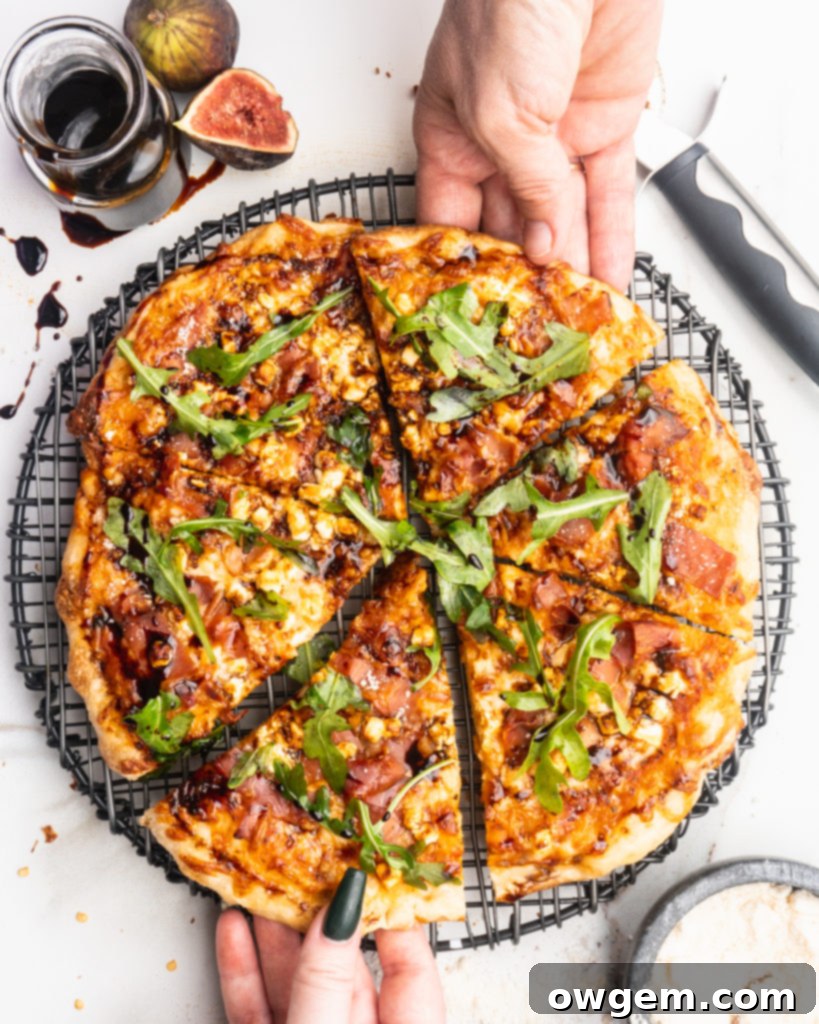
The Dynamic Duo: Balsamic Reduction and Goat Cheese
Let’s talk about the incredible synergy between balsamic vinegar reduction and goat cheese – a pairing that is positively sublime and elevates any dish it graces. Goat cheese, with its distinctively tart, tangy, and sometimes earthy flavor profile, finds its perfect match in slightly sweet complements. Think of classic combinations like goat cheese with fresh strawberries, or how it’s often served alongside a rich red wine reduction. This interplay of tartness and sweetness is a culinary match made in heaven, creating a sophisticated balance that delights the palate.
Given this delightful culinary principle, incorporating a balsamic reduction into this Prosciutto and Goat Cheese Pizza was an absolute no-brainer. Balsamic reduction, as its name suggests, is simply balsamic vinegar that has been slowly simmered and boiled down until it thickens into a glossy, syrupy consistency. During this reduction process, the vinegar’s natural sugars caramelize, intensifying its flavor and making it significantly sweeter and less acidic than its unreduced form. The result is a rich, complex syrup with notes of fig, cherry, and molasses, offering a luxurious sweetness that beautifully contrasts the savory and salty elements of the prosciutto and the sharp tang of the goat cheese.
Balsamic reduction is readily available at most gourmet grocery stores, but you can also easily make your own at home by simmering good quality balsamic vinegar over medium-low heat until it reduces by about half and coats the back of a spoon. If you’re wondering about other uses for this versatile condiment, the possibilities are truly endless! It shines in various salads, adding a gourmet touch to a simple Greek salad, a vibrant strawberry salad, or a classic Caprese. It’s also fantastic drizzled over grilled chicken, roasted vegetables, or even fresh fruit. One of my favorite applications is adding it to beef short ribs, where its depth of flavor complements the rich meat beautifully. Don’t be shy about keeping a bottle on hand – once you discover its magic, you’ll find countless ways to incorporate it into your cooking.
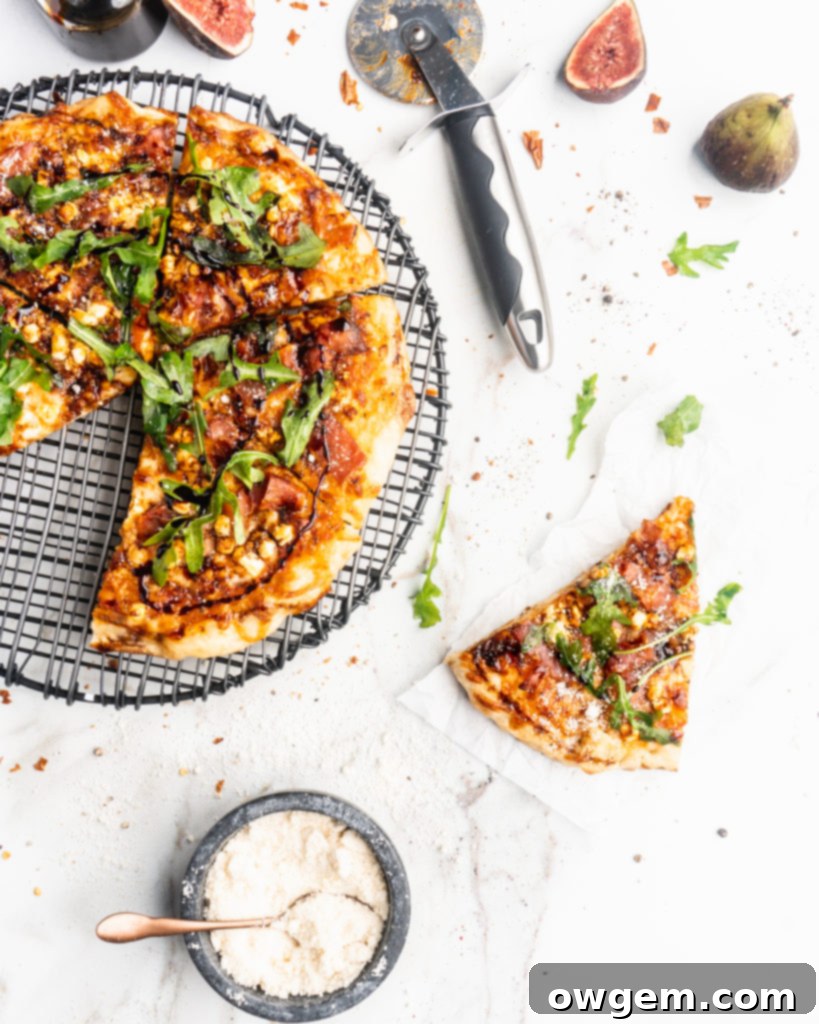
Building Your Cast Iron Masterpiece: Tips for Success
Creating the perfect Prosciutto and Goat Cheese Cast Iron Pan Pizza involves a few simple steps, but paying attention to certain details can make all the difference. Beyond the technique of oiling your work surface for dough shaping, consider these tips:
- **Preheating the Oven and Pan:** Ensure your oven is fully preheated to 450°F (230°C). Crucially, the cast iron pan should also be heated on the stovetop before adding the dough. This initial stovetop heat is what gives the crust its incredible crispness. Don’t skip this step!
- **Dough Placement:** Once the pan is oiled and the dough is stretched, carefully transfer the dough into the hot cast iron skillet. Press it gently to ensure it covers the bottom and extends slightly up the sides, creating a natural crust edge.
- **Sauce and Toppings Distribution:** A common mistake is to overload the pizza with sauce and toppings. For a 12-inch pizza, 2-3 tablespoons of marinara are usually sufficient to provide flavor without making the crust soggy. Spread the sauce evenly, leaving a small border for the crust. Drizzle the initial balsamic reduction sparingly, allowing its intense flavor to come through without overpowering.
- **Layering Flavors:** The order of toppings matters. Start with a layer of shredded mozzarella – this creates a cheesy base that helps bind the other toppings. Then, artfully arrange the strips of prosciutto. As it bakes, the prosciutto will crisp up slightly, intensifying its savory notes. Finally, dot the pizza with crumbled goat cheese. Its creamy texture and sharp tang will melt beautifully into the mozzarella, creating pockets of rich flavor.
- **Stovetop Start for Crispiness:** The initial cook on the stovetop (medium-high heat) is vital. Watch the bottom of the crust carefully; it should start to turn golden brown and crisp up within a few minutes. This foundational crispness is what prevents a soggy pizza base.
- **Oven Finish for Even Cooking:** Once the bottom is browned, move the pan to the top rack of your preheated oven. This ensures even cooking and allows the cheese to melt and bubble beautifully, turning a glorious golden color. Keep an eye on it – ovens vary, so adjust baking time as needed.
- **Resting Period and Fresh Finish:** After removing the pizza from the oven, resist the urge to cut into it immediately. Letting it cool for about 5 minutes allows the cheese to set and the crust to become even crispier. This is also the perfect time to add the fresh arugula and a final drizzle of balsamic reduction. The arugula adds a fresh, peppery contrast to the warm, rich pizza, and the extra balsamic reduction brings a final touch of sweet-tart complexity.
By following these detailed tips, you’re not just making a pizza; you’re crafting a culinary experience. This Prosciutto and Goat Cheese Cast Iron Pan Pizza is a testament to how simple ingredients, combined with smart techniques, can yield truly extraordinary results right in your home kitchen. Enjoy the process, and savor every bite of your gourmet creation!
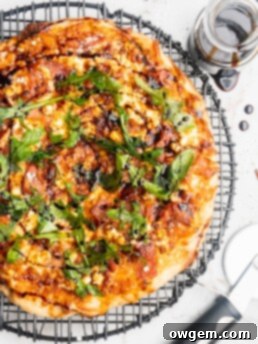
Get the Recipe:
Prosciutto and Goat Cheese Cast Iron Pan Pizza
Pin
Rate
Ingredients
- 12 oz Pizza Dough
- 1 tbsp Extra Virgin Olive Oil
- 2-3 tbsp Marinara Sauce or Pizza Sauce
- 1 tsp Balsamic Vinegar Reduction
- 1/2 cup Shredded Pizza Mozzarella
- 4 Thinly Sliced Pieces of Prosciutto, cut into about 1” strips
- 1/4 cup Crumbled Goat Cheese
- Handful of Arugula
- Balsamic Reduction, for drizzling
Instructions
-
Preheat oven to 450°F. Shape pizza dough on an oiled work surface into a round circle that is about 12” in diameter. Place oil into a 12” cast iron pan, then place dough over top.
-
Build your pizza in the pan by adding the marinara/pizza sauce and balsamic reduction to the center of the pizza. Using a spoon, spread the balsamic and sauce to the outer edges. Top the pizza with the mozzarella, then the prosciutto, and then finally with the crumbled goat cheese.
-
Place pan over medium-high heat. Cook the pizza on the stove until the bottom of the crust begins to brown, then place into the oven on the top rack. Bake the pizza for 10-14 minutes, or until the cheese is bubbling and turning golden.
-
Remove pan from the oven and allow the pizza to cool for around 5 minutes. Top with arugula and drizzle with more balsamic reduction, then cut with pizza cutter and serve.
